By Kathy Tretter
Editor, The Ferdinand News
Special to The Message
It was a day almost eight years in the making!
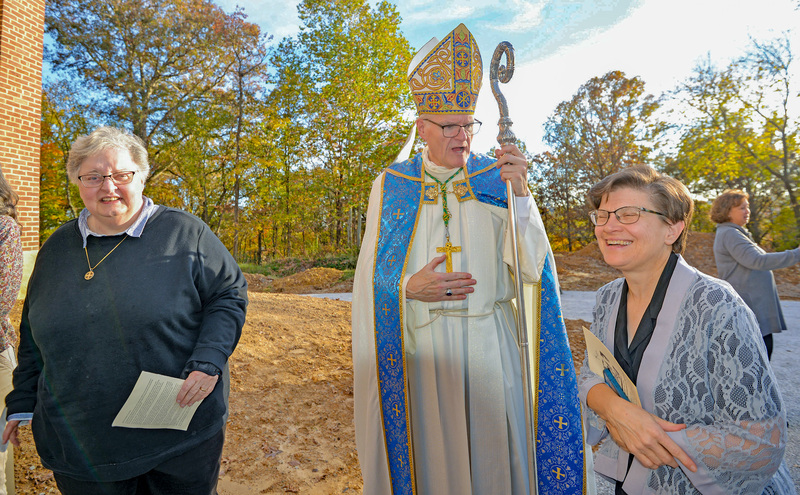
On Nov. 5, with the sun washing the landscape in a golden light, Evansville Bishop Joseph M Siegel blessed the niches and rededicated the Chapel of Our Sorrowful Mother as a columbarium to hold the cremains of those who choose cremation.
The chapel had been the vision of Ferdinand founding father Rev. Joseph Kundek, who did not live to see the reality. It was built in 1876 on Mt. Calvary – a hill east of St. Ferdinand Church and south of the Monastery Immaculate Conception quadrangle on Mt. Tabor – by Father Eberhard Stadler, with the cornerstone laid June 18, 1876, by Saint Meinrad Abbot Benedictine Father Martin Marty. Construction was completed and the chapel dedicated on March 23, 1877, on the Feast of the Seven Sorrows of the Blessed Virgin Mary.
That day was filled with blessings and processions with the congregation making its way up the steep hill to the chapel; and, to a degree, that celebration was replicated Nov. 5, although attendees made their way by car, and golf carts were used to transport those who might find it a difficult climb.
The restoration was completed in four phases, the first to replace the roof and gutters and repair the bell tower and steeple. Phase two was scheduled for tuck-pointing the brick and foundation (except for the portal and stone trimmings, the Romanesque exterior is brick). Phase three included window restoration and storm-window installation. The final phase was dedicated to the interior restoration.
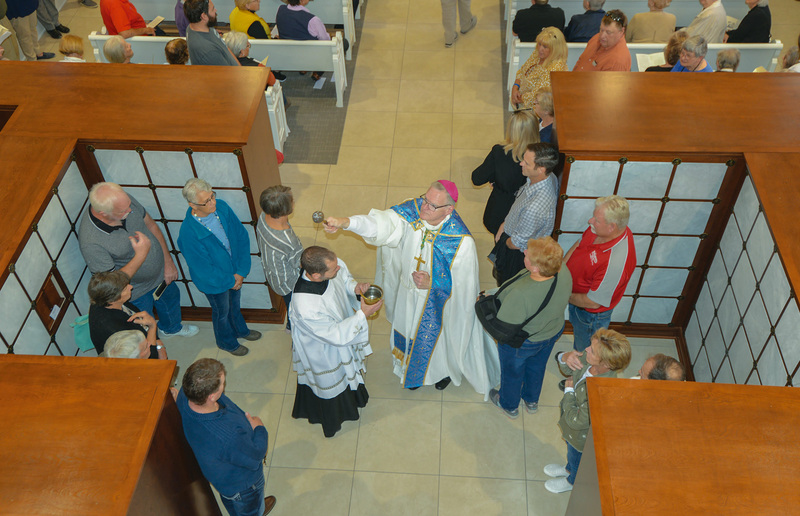
Special recognition must be given to Diane and Alvin Hoppenjans, along with Ralph Pund, who jointly served as clerks of the works and oversaw every step of the project.
Diane penned the following, which was included on the back of the program and truly expresses the thoughts of committee members who assisted with this project:
Dear Friends in Christ,
To attempt to thank everyone who played a part in restoring the Chapel of Our Sorrowful Mother would be a task beyond measure just as measuring the gratitude in our hearts would be!
From the start, the support has been sincere and solid, unwavering and true, driven, yet patient, understanding of the inherent process of planning, researching, applying for grants, fundraising, orchestrating a phase, and then repeating the process all over again. Each phase led us to the next “promised land” as our belief that we could complete the Chapel Restoration Project grew.
Thank you for your prayers and for your faith in us! Thank you to our skilled laborers and to the many volunteers completing the task at hand! The work of many hands was met with a deep sense of purpose as God led us step-by-step, timing it His way. Donations of money and skills continued throughout making it all possible, and for that, we cannot thank you enough!

To our founding father, Father Joseph Kundek, your vision eventually led to a monument to Christ being built in honor of His Mother, Mary, most holy, on this hill you called Mt. Calvary. You established a community based on faith. Thank you and those who followed in your mission, especially Father Eberhard Stadler who fulfilled your dream for this hill overlooking the town you named “Ferdinand”.
The Chapel of Our Sorrowful Mother held a special place in the hearts of many who have gone before us, some who inspired us to see to its renovation. May they be looking down on it today with a sense of fulfillment and pride, knowing they were with us throughout! To them we say, “You are with us still!”
May every person who visits find the chapel and its grounds a place where they find peace of mind and spirit! Our ancestors gifted it to us for that purpose. We thank them and all of you for gifting it to this and future generations!
With our sincerest gratitude! God bless you All!
Chapel Restoration Committee: Father Anthony Govind, Alvin and Diane Hoppenjans, Lori Klem, Ralph Pund, Gloria Rahman, Kathy Tretter and Sr. Barbara Lynn Schmitz
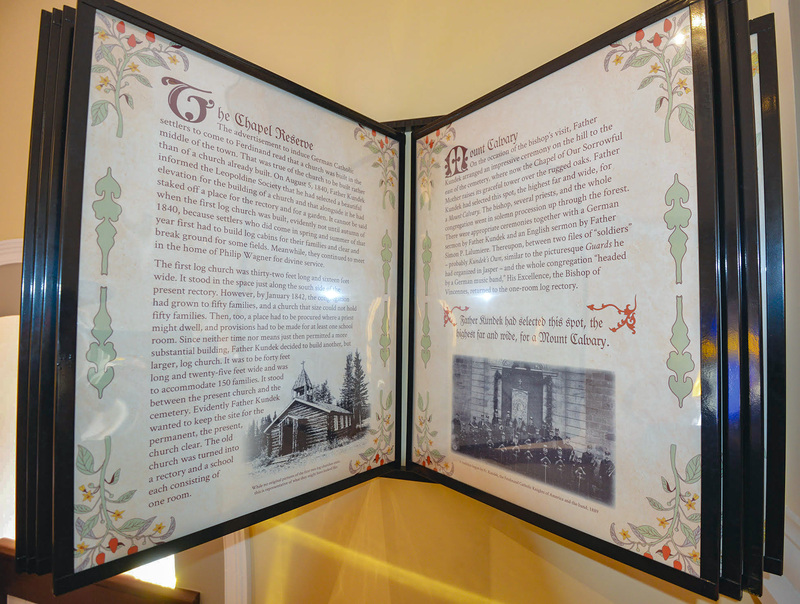
About the Chapel and its restoration
It’s been a long time coming — although sometimes it feels like only yesterday when work began to restore the Chapel of Our Sorrowful Mothers to its former glory.
One feature not to be missed in this newly restored space is the Snippets of History in the choir loft, where Father Eberhard Stadler’s desk also holds a place of honor. The Snippets of History features massive framed pages telling the story (with pictures) of Ferdinand’s founding. Readers may remember it was Father Eberhard who fulfilled Ferdinand founder Father Joseph Kundek’s vision to place a chapel on Mount Calvary Hill.
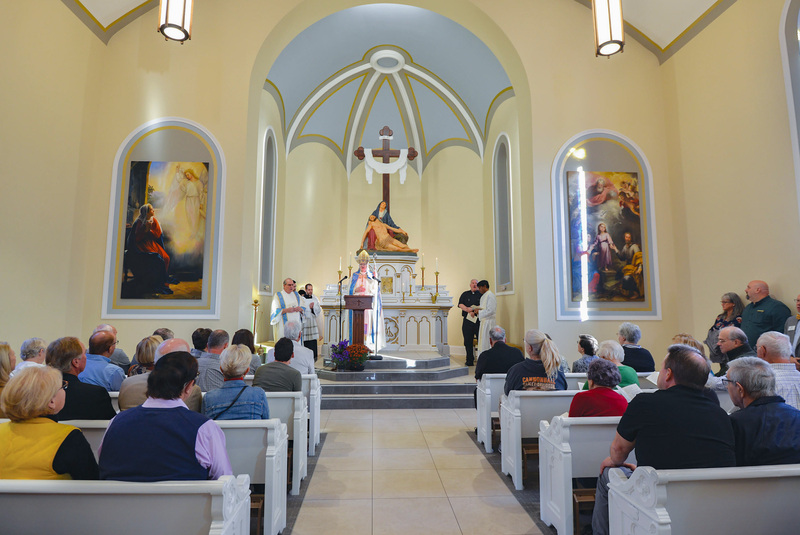
Here’s how this restoration came to pass.
The Ferdinand Historical Society hosted a gathering for Indiana Landmarks in 2015, during which the Society was honored with an award for the restoration of the Wollenmann House. Camile Fife, who wrote the nomination to get the house on the National Register, mentioned to Diane Hoppenjans, “Now that you’re done with the Wollenmann House you can start on the chapel.”
The chapel was already on the Society’s radar and the first of what would be many meetings was held Feb. 1, 2016.
The purpose for this sacred space was the first question in need of an answer.
The late Father John Schipp posited the idea of a collumbarium, explaining that many more people were choosing cremation.
A feasibility study followed, along with an application to get all of St. Ferdinand’s property on the National Register, which took a while to be approved.
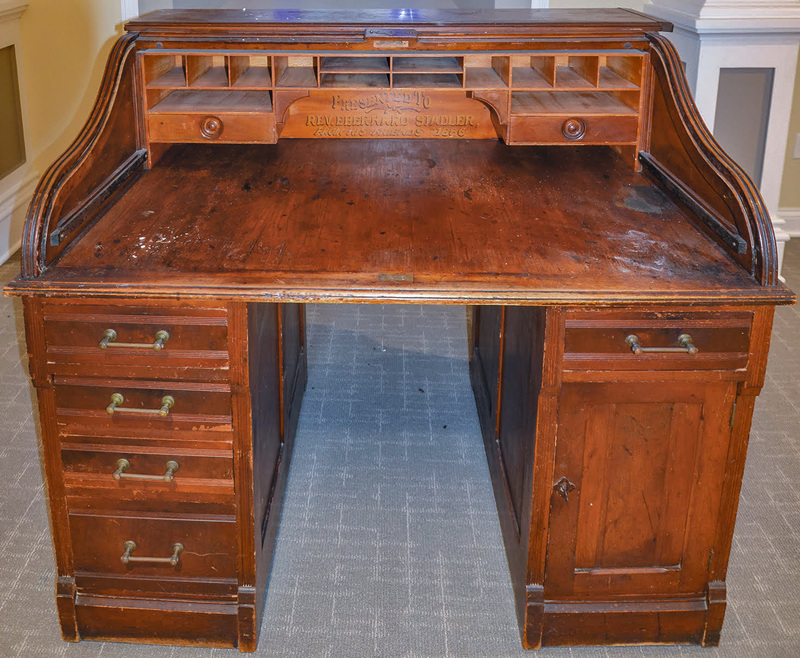
Fundraising began in earnest, and grants helped along the way – including a $100,000 Historic Preservation Grant from the Indiana Office of Community and Rural Affairs and $35,000 from the Dubois County Community Foundation. The total cost came in over $1 million, so all the donations were essential. For a bit of perspective, the chapel, built in 1876-77, cost $6,464.64 when it was built.
Diane and Alvin Hoppenjans took the lead on the project, and Ralph Pund was a Godsend when he joined the team. Together, he and Alvin served as clerks of the work. The late Jane Jochem and Joan Lange at St. Ferdinand were indispensable, keeping track of all the donors and handling much of the paperwork.
Many, many people came forward with donations of labor. Some work, including exterior landscaping, is continuing. This project has truly been a labor of love.
